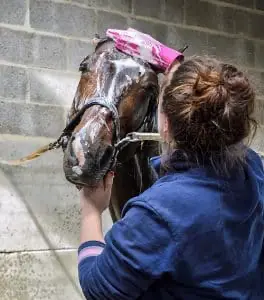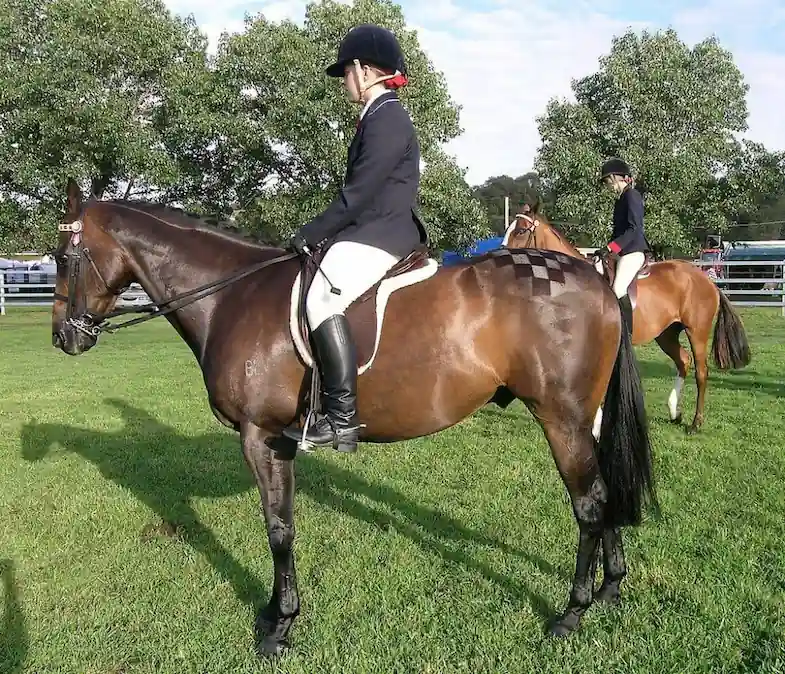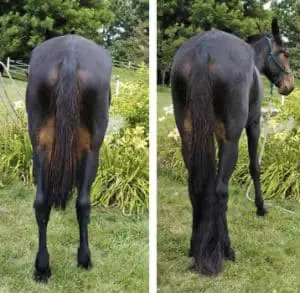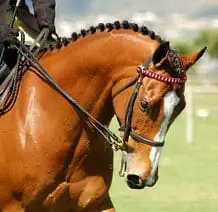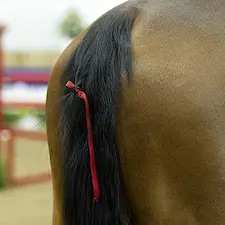With the show season fast approaching we all know that planning is key but that doesn’t mean to say it’s going to be stress-free. After all, from days before to the moment you enter the ring, it can be pretty hectic. While there’s nothing anybody can do to take the nerves away (in fact they can be a good thing) I’ve picked up a number of hacks over the years that I’m sure will make your show life a little easier, and possibly relieve some of that stress.
Pre-show preparation
Of course, some things such as washing your horse can only be done a day or two before the show but there are still plenty of things you can do long in advance, such as getting your kit ready and making sure all of your tack is in good order.
Tack
Repair leather – You don’t need to pay for expensive repairs if you’ve got a few scratches on your saddle, you can fix most of them yourself for a fraction of the cost – all you need is a soft cloth and a little bit of olive oil. Make sure the area is clean then gently rub some of the oil into the damaged area. Start by using a small amount of oil, you can always repeat the process if it doesn’t come out the first time.
Polish that metal – While the metal on your tack is only a small part of it it can still make a big difference, after all, it’s the overall effect you’re going for. Don’t worry though a bit of metal (silver or brass depending on the color) polish will get them really clean and bring out the shine, especially on D rings and buckles. Just don’t use it on any metal that’s going to go into your horse’s mouth or near his eyes.
No saddle soap? – Don’t worry if you don’t have any saddle soap, I haven’t actually used it for years! Instead, I clean the leather with Pledge because I find it gets the dirt off even better than saddle soap and also cleans the saddle. Once I’ve done that I then use beeswax, again it’s great for cleaning leather but it also softens it too.
Stop your feet from slipping – Okay so whether your feet slip in the stirrups or not isn’t really part of your pre-show preparation but I didn’t know where else to put this. Cut a little piece of sandpaper (the coarser the better) and stick it to your stirrups, your feet will now stay in place and no longer slide through.
Washing
Remove sweat before washing – I know you’re going to wash the sweat stains out of your horse’s coat anyway but it’s far better to get rid of them before. Mixing a little bit of apple cider vinegar with warm water will get rid of the toughest sweat and grass stains. If your horse only has a few grass or sweat stains then you can use a baby wipe instead, rubbing the area with the wipe will get rid of any marks.
Post wash shine – After you’ve washed your horse, rinse his coat with a little bit of white vinegar to remove all of the soap suds. This will not only get rid of all of them but will also add shine to his coat. If your horse has any open cuts avoid those areas, as well as his face.
Mud free hooves – For some reason, clean hooves seem to act as a magnet to mud and dirt after you’ve washed your horse but with a little bit of WD-40 you can easily prevent this. Once they’re completely dry, cover the feathers and then either spray WD-40 on the hooves or brush it on. It’ll the mud off but any mud that does get onto them can simply be wiped off.
Overnight – If you’re washing your horse on the day before the show then, if possible, stable him overnight to stop him rolling and getting dirty again. Ideally, you want to use a summer rug and leg bandages to keep bedding and dust out of his coat.
Quick freshen up – No matter how much you try you’ll never be able to keep your horse completely clean after washing him but don’t worry you can go over any patches with a baby wipe to get them spotless again.
Grooming
Really white tail – We all know how any white parts of our horses seem to get dirtier than the rest of them and the tail is no exception – if anything it seems to get the dirtiest of all. You might be surprised to know but tomato ketchup is the key to getting the white back into it! Cover the tail in ketchup, making sure it’s all covered, and leave it for around 20 minutes before thoroughly rinsing all of the ketchup out. You’ll be amazed at just how white the tail comes up.
Brilliant white socks – If your horse has white socks or stockings then after you’ve washed and dried his legs rub a little bit of baby powder into them. You can use whitening powder that has been developed especially for horses, but baby powder is just as good and is perfectly safe for horses. Just make sure your horse’s legs are completely dry otherwise the powder is likely to clump together.
Remove chestnuts – If your horse’s chestnuts and ergots are getting a bit long and you want to remove them before the show cover them in vaseline or baby oil and leave them for around 15 minutes. You should then be able to simply peel them off.
Remove mud and dead hair – I know I’m stating the obvious when I say you need to get rid of any mud but if you use a metal pan scourer it’ll not only remove the mud but will also remove dead hairs. When I first heard this tip I was too worried to use a scourer in case it pulled my horse’s hair out, it didn’t though, it left all of the healthy hairs and just removed the mud and old hairs.
Quarter markings – If you’re thinking of using quarter markings I personally prefer to do them the day before. This way I’ve got the time to redo them if they go wrong, or completely remove them if I’m not happy. When doing the markings work on a small area at a time and keep it simple, you can then use hair spray to keep them in place.
Your outfit
New riding boots – You can easily soften up brand new riding boots by wearing them with wet socks. I know this will fill a little bit odd and uncomfortable as your feet will feel ‘squelchy’ but its the quickest way to soften the boots up and mold them to your feet and legs. Just don’t wear them like this on show day.
Add shine to your riding boots – Everybody’s got their own tips for making their leather boots really shine but I’ve found the best method is the pantyhose one! All you need to do is get an old pair, scrunch them up into a ball and then simply buff your boots to a brilliant shine.
Keep your riding helmet smelling sweet – Nobody likes a smelly riding helmet, especially on show day but the good news is that you can prevent sweat from building up which is what causes the smell. Wearing a bandana under your helmet when you’re riding will stop the sweat from getting through to the lining of your helmet.
Clean a smelling riding helmet – If your helmet is already a little bit on the sweaty side then don’t worry you can use a little bit of soapy water to wash the lining (don’t get it too wet though and remove all of the soap after) and then use a hairdryer to dry it after. Or if you’d prefer a quick fix is to spray it with Febreze and then hang it up to dry. You may need to repeat this a few times to get rid of the smell completely.
Look after your boots – You can use a boot tree to help keep your boots upright and crease-free but these can be expensive so why not use pool noodles instead? These are a fraction of the cost of boot trees but work just as well. You can cut them to size and, if your boots are wide, you can use a couple in each boot.
Show day hacks
While the majority of your preparations will be done before the show there are some things that can only be done on the day, they’ll also be a few things that will need to be redone, albeit to a lesser extent.
Perfect braids, every time – It can be difficult to get the braids the same every time but if you put a few plaiting bands of the teeth of your mane comb (or plaiting comb) then you’ll have a marker in place to make sure they’re the same size time after time. You’ll also have the bands to hand as soon as you need them so there’s no chance of the braids coming undone.
Keeping plaits neat – Once you’ve finished plaiting your horse’s mane (and tail if yours showing in-hand) you can easily tame any loose or flyaway hairs by rubbing them with a dryer sheet (such as Bounce). This will remove the static and then you can use a bit of hair spray to keep them in place.
Using a fake tail – If you’re using tail extensions then you’ll know their hair doesn’t always feel so natural and can be a bit staticky, just with the previous hack you can use dryer sheets to tame them. If, however, you find they don’t feel very ‘horse-like’ apply a little bit of fabric softener to the whole tail, including then extensions. This will help to condition it but also to soften up the fake hair.
Revive the shine of your horse’s coat – While you will, of course, have already washed your horse’s coat, on the day of the show you’ll want to refresh it and add shine to it. This can easily be done with a few household items, such as baby wipes and oil. Before grooming your horse use a baby wipe to remove any dirty marks such as sweat and grass stains. This will also add a bit of shine but you can use baby oil to get your horse’s coat really shining. It’s a fraction of the cost of show shine and can even be used on the horse’s face, just be careful around the eyes.
Quick grooming cloths – If you need to quickly spruce up your horse’s coat before a particular class you can use microfibre cloths to do this. They’re perfect for giving the coat a quick shine but also work wonders when it comes to drying your horse’s coat too. They’re available in a range of colors so you can keep different clothes for different areas, and after the show, you can simply put them in the washing machine.
Get rid of green foam – There’s nothing worse than your horse salivating green foam just before you enter the show ring because he’s been munching on the grass. While you could, of course, stop this by not letting him eat the grass in the first place but that wouldn’t be very fair. Instead, why not use a large syringe filled with water to rinse his mouth out. You’ll be able to get rid of the grass and foam without making a mess.
Keep everything to hand – It’s a nightmare when you can never find what you’re after but with a stall chain you can keep everything together. You can hang blankets, saddle pads, and horse boots over it but you can also hang small items from it too.
Multipurpose storage – Why waste space taking your entire grooming kit and chairs with you when you can combine the two of them? A storage stool would not only save you space but would also help to keep your grooming kit easily to hand.
What are the show judges looking for when inspecting a horse?
It can be difficult to know what the judges are looking for and what is going to reduce your marks but hopefully, the below will help you.
Mane – Unless your class requires horse or ponies to be shown with a loose mane (and tail) you should always plait the mane. Keep the plait simple and have an odd number of them, excluding the forelock.
Tail – If you’re entering an in-hand class the tail should be neatly plaited with no flyaway strands, if however, you’re entering a riding class then the tail should be loose but pulled and neatly cut to just below the hocks.
Whiskers – The whiskers should be neatly trimmed, as should the jowls, heels, and ears. Don’t cut them so short that it alters the horse’s appearance, just make them even.
Coat – The horse’s coat should be in good condition with a natural shine, white markings should also be as white as possible without being obviously artificially whitened.
Hooves – The hooves should be trimmed, even and in good condition. They should be oiled but depending on the breed and the class you may only be allowed to use clear oil rather than oil that will artificially darken the hooves.
Your hair – If you’ve got long hair then put it neatly in a bun and keep it under a hairnet, this will keep it neat and out of the way. Whatever you do, don’t wear brightly colored scrunchies, you might think it looks nice but the judges won’t agree with you.
Avoid bling – Let’s be honest we all like a bit of bling now and then but it’s not for the show ring. Yes, it might make you stand out from the rest of the riders but in the judge’s eye you’ll stand out for the wrong reasons. The judges are after understated elegance not in your face bling.
Attire – Keep your clothing simple and tidy, if you have to wear a necktie or pin make sure they’re both level and even. Keep your boots plain too with straight tops – avoid shaped boots.
Don’t forget a tail ribbon – If your horse needs to wear a ribbon in his tail make sure it’s neat and tidy but keep it subtle too. Just in case you’re not sure what each ribbon means the following should help:
- Red – This means that the horse is a kicker and that you shouldn’t get too close.
- Blue or Yellow – Both mean the horse is a stallion but blue is sometimes used for aggressive geldings too.
- Green – Young or inexperienced horses where green ribbons.
- Pink – These are reserved for mares in season.
- White – Horses that are for sale wear a white ribbon.
Further Reading
- Household items that are yard essentials
- Life hacks for horse owners
- Groom your horse like a pro
- How to clip your horse
- How to thoroughly clean your tack
- Preparing for your first show
- How to bond with your horse
- Pony camp packing list
I hope you found this article helpful. If you did I’d be grateful if you could share it please as it would really help me.
Recommended products
Over the years I have tried hundreds of different horsey products, from various blankets and halters to different treats. Some I’ve loved, others I’ve hated but I thought I’d share with you my top all-time favorite products, the ones I never leave the yard without. I’ve included links to the products (which are in no particular order) that I really think are great.
- Horse Knots by Reference Ready – If you’re like me and enjoy pocket reference guides then you’ll love this knot tying guide. These handy cards can easily fit in your pocket or attach to the saddle for quick reference. They’re waterproof, durable and are color coded to make them easy to follow.
- Mane ’n Tail Detangler – Even if you never show your horse you’ll need to detangle his tail from time to time (and possibly his mane too) which is always a challenging chore! I’ve found that if I run a little bit of detangler through my horse’s tails every few days it stops them from getting matted up and makes combing them easy, even if they’re coated in mud. I don’t know if I should admit to this or not but it also works wonders on my hair.
- TAKEKIT Pro clippers – Over the years I’ve tried a lot of different clippers and while some were obviously better than others I found these to be by far the best. They are heavier than a lot of other clippers but for me, that’s a good thing, it makes them feel more sturdy and hardwearing. On top of that they have a range of speeds so are just as good for clipping your horse’s back as they are his face. I also like the fact that they come in a handy carry case but that’s not for everybody. The company that makes them is super good and incredibly helpful too, a real bonus these days. The only thing I wasn’t keen on was the fact that it doesn’t come with any oil, but that’s not a major problem as it’s not difficult to buy lubricant.
- Shire’s ball feeder – There are so many boredom buster toys out there but I like to use these every day, regardless of whether or not my horses are bored. I find that it helps to encourage my horses to problem solve by rewarding them with treats (or pieces of fruit) but it also mimics their natural grazing behavior which helps to keep them calm and de-stressed.
- Horse safe mirror – This is a strange one that many people are surprised about but I like to put horse safe mirrors in the trailers as well as in the quarantine stalls. It helps to prevent the feeling of isolation by giving the impression of other horses being around. Being herd animals horses can get extremely stressed when they feel that they’re on their own but with these stick-on mirrors, they believe that at least one other horse is with them.
- Rectal thermometer – I know this isn’t glamourous at all but it’s vital for your horse’s well-being to be able to check their temperature and a rectal thermometer is the easiest way of doing this which is why I’ve added it to the list.
Shopping lists
I’ve also put together a few shopping lists of essential items that I’ve found helpful over the years. I’ve broken the lists down into different categories rather than put everything in one massive list 😉

